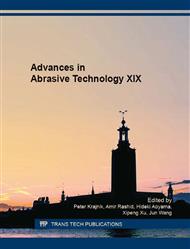[1]
D. Nakamura, I. Gunjishima, S. Yamaguchi, T. Ito, A. Okamoto, H. Kondo, S. Onda, and K. Takatori, Ultrahigh-quality silicon carbide single crystals, Nature. 430 (2004) 1009.
DOI: 10.1038/nature02810
Google Scholar
[2]
E.N. Mokhov, O.V. Avdeev, I.S. Barash, T.Y. Chemekova, A.D. Roenkov, A.S. Segal, A.A. Wolfson, Y.N. Makarov, M.G. Ramm, and H. Helava, Sublimation growth of AlN bulk crystals in Ta crucibles, Journal of Crystal Growth. 281 (2005) 93.
DOI: 10.1016/j.jcrysgro.2005.03.016
Google Scholar
[3]
V.C. Venkatesh, I. Inasaki, H.K. Toenshof, T. Nakagawa, and I.D. Marinescu, Observations on Polishing and Ultraprecision Machining of Semiconductor Substrate Materials, Annals of the CIRP. 44 (1995) 611.
DOI: 10.1016/s0007-8506(07)60508-3
Google Scholar
[4]
J.J. Watanabe, S.H. Hong, K.S. Yamaguchi, M. Touge, and N. Kuroda, Effect of TiO2 and CeO2 Particles on SiC Semiconductor Surfaces Polished Under Ultraviolet-Ray Irradiation, SME International Grinding Conference. ISAAT (2007) 1.
Google Scholar
[5]
H. Hara, Y. Sano, H. Mimura, K. Arima, A. Kubota, K. Yagi, J. Murata, K. Yamauch, Novel Abrasive-Free Planarization of 4H-SiC (0001) Using Catalyst, Journal of electronic materials. 35 (2006) 11.
DOI: 10.1007/s11664-006-0218-6
Google Scholar
[6]
C.H. Li, I.B. Bhat, R.J. Wang, and J. Seiler, Electro-Chemical Mechanical Polishing of Silicon Carbide, Journal of electronic materials. 33 (2004) 481.
DOI: 10.1007/s11664-004-0207-6
Google Scholar
[7]
L. Zhou, V. Audurier, P. Pirouz, and J.A. Powell, Chemomechanical Polishing of Silicon Carbide, Journal of the Electrochemical Society. 144 (1997) 161.
DOI: 10.1149/1.1837711
Google Scholar
[8]
C.L. Neslen, W.C. Mitchel, and R.L. Hengehold, Effects of Process Parameter Variations on the Removal Rate in Chemical Mechanical Polishing of 4H-SiC, Journal of Electronic Materials. 30 (2001) 1271.
DOI: 10.1007/s11664-001-0111-2
Google Scholar
[9]
H.S. Lee, and H.D. Jeong, Chemical and mechanical balance in polishing of electronic materials for defect-free surfaces, CIRP Annals - Manufacturing Technology. 58 (2009) 485.
DOI: 10.1016/j.cirp.2009.03.115
Google Scholar
[10]
H.J. Lee, B.Y. Park, S.H. Jeong, S.B. Joo and H.D. Jeong, The effect of mixed abrasive slurry on CMP of 6H-SiC substrates, Journal of Ceramic Processing Research. 10 (2009) 378.
Google Scholar
[11]
H.S. Lee, D.I. Kim, J.H. An, H.J. Lee, K.H. Kim, and H.D. Jeong, Hybrid polishing mechanism of single crystal SiC using mixed abrasive slurry (MAS), CIRP Annals - Manufacturing Technology. 59 (2010) 333.
DOI: 10.1016/j.cirp.2010.03.114
Google Scholar
[12]
X.F. Chen, J. Li, D.Y. Ma, X.B. Hu, X.G. Xu, and M.H. Jiang, Fine Machining of Large-Diameter 6H-SiC Wafers, J. Mater. Sci. Technol. 22 (2006) 681.
Google Scholar
[13]
K. Yamaguchi, M. Touge, T. Nakano, and J. Watanabe, Study on lapping and constant-pressure grinding of single-crystal SiC, Advanced Materials Research. 76-78 (2009) 282.
DOI: 10.4028/www.scientific.net/amr.76-78.282
Google Scholar
[14]
L. Yin, and H. Huang, Brittle materials in nano-abrasive fabrication of optical mirror-surfaces, Precision Engineering. 32 (2008) 336.
DOI: 10.1016/j.precisioneng.2007.09.001
Google Scholar
[15]
H. Kasuga, H. Ohmori, T. Mishima, Y. Watanabe, W. Lin, Investigation on mirror surface grinding characteristics of SiC materials, Journal of Ceramic Processing Research. 10 (2009) 351.
Google Scholar
[16]
C.Y. Shih, P.L. Tso, and J.C. Sung, Analysis of Fixed Abrasive Pads with a Nano-Sized Diamond for Silicon Wafer Polishing, Advanced Materials Research. 76-78 (2009) 410.
DOI: 10.4028/www.scientific.net/amr.76-78.410
Google Scholar
[17]
H. Nakamura, J.W. Yan, K. Syoji, and Y. Wakamatsu, Development of a Polishing Disc Containing Granulated Fine Abrasives, Key Engineering Materials. 238-239 (2003) 257.
DOI: 10.4028/www.scientific.net/kem.238-239.257
Google Scholar
[18]
J. Lu, Y. Li and X.P. Xu, The effects of abrasive yielding in polishing of SiC wafers with semi-fixed flexible pad, Proceedings of the Institution of Mechanical Engineers, Part B: Journal of Engineering Manufacture. 229 (2015) 170.
DOI: 10.1177/0954405414563556
Google Scholar
[19]
J. Lu, Q.F. Luo, Y.Y. Song, G.Q. Hu, and X.P. Xu, Fabrication and Application of Gel-bonded Ultrafine Diamond Abrasive Tools, Journal of mechanical Engineering. 159 (2015) 41.
DOI: 10.3901/jme.2015.15.205
Google Scholar


